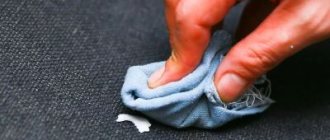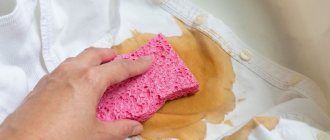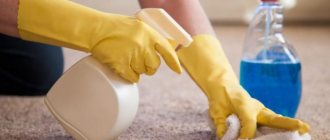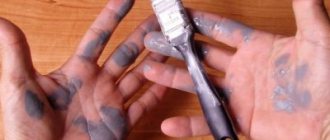Mothers like slime much less than children, but the fact is that it is quite difficult to remove slime from clothes or from furniture upholstery or carpet.
Since regular washing with powder does not always help clear stains from slime (from the English word “slime,” another name for this toy), various folk and chemical remedies will come to the rescue.
Freezing helps a lot; in this way you can remove sticky residue from clothes and even hair. But there are many other proven methods that we will discuss in this article.
Some housewives use tape or pieces of slime. It is enough to stick the product to the contaminated area, sharply tear it off and repeat until all the substance has left the tissue.
Even dried slime can be removed mechanically. The method is fundamentally not suitable for delicate fabrics; for them it is better to use freezing.
Freezer
Cleanses freezing mucus well. The soiled item is placed in a chamber with a low temperature, having previously been wrapped in a bag; you can also simply apply an ice cube to the dirty area.
Then scrape off the stains with a knife. You need to act carefully so as not to damage the fabric.
In some cases, it is not possible to completely remove traces of slime, then you need to repeat the procedure or try other methods.
With ice
If it is not possible to place spoiled clothes in the freezer, then you can use ice cubes - they simply cover the stuck toy with them, periodically change them to “fresh” ones and achieve stable solidification of the mass.
After removing the slime, stains may remain on the fabric; they are removed using one of the methods suggested in the article - cleansing with a knife, then washing. If the slime was large and spread across the clothes in a large stain, then during its removal the toy may “melt”, in which case you will need to repeat the procedure with freezing.
Cleaning Features
There are several rules that should be followed when washing fabrics. The cleansing procedure is carried out in several stages.
Step 1. Mechanical cleaning
First of all, you need to remove the slime manually: rub the stain that appears in the direction from the edge to the center so that the dirt does not become larger. It is best to take a hard brush, but not a metal one, so as not to damage the fabric. To remove stains from thick, picky material (jeans, trousers, shorts, jackets), you can also use a nail file or a dull knife. If preliminary cleaning is not carried out, the slime is more likely to spread further, in which case it will be impossible to save the product.
Advice! Handgum can be removed from those things that are easily damaged by a file using chewing gum or plasticine.
Step 2. Washing with active product
After mechanical treatment, you should proceed to the main stage of removing contaminants: cleaning using the chosen method. The active substance will help dissolve the slime and remove it from the fibers of the material.
Delicate fabrics (silk, satin, etc.), as well as synthetics, should not be exposed to high temperatures or strong chemicals. This will lead to damage to the fiber structure, stretching or, conversely, shrinkage of things.
Colored fabrics should also not be treated with alcohol, solvents, acetone, hot air, or boiling water, otherwise the damaged area may fade.
Sometimes it is better not to try to wash the product yourself, but to use dry cleaning services. You need to do this if none of the methods help. It is also not recommended to try to clean clothes from famous brands made from expensive fabrics, natural fur, carpets, rugs, fur coats, jackets and furniture covers on your own.
It is very difficult to remove stains from silk and satin without causing harm to them. It is also worth using dry cleaning services if the slime stains are already several weeks or even months old.
Step 3: Regular wash
Next, you need to wash off the remaining traces of the slime and the smell of the products used. This can be done by washing in an automatic machine or by hand.
Attention! You should not delay processing the fabric: you should wash it immediately after getting slime or, if this is not possible, within 2-4 hours from the moment of contamination.
When using aggressive household chemicals, do not forget about protection: thick household gloves, a medical mask. If caustic professional products come into contact with the skin or mucous membranes, you must immediately rinse the damaged area with clean water; in especially serious cases, it is better to consult a doctor.
How to remove slime from clothes at home very quickly
We use high temperature. Hot water (above 60 degrees) dissolves the slime in a few minutes. But this method must be applied immediately. To remove slime from fabric, leave the item in hot water for 30 minutes. After the time has passed, wash the stained area by hand. Then hold the item under running hot water. This method will allow you to wash slime from clothes without extra costs. Please note that not all fabrics can be used with hot water.
Laundry soap
Using regular laundry soap, you can try to clean the slime stain if it has appeared on your clothes recently. It is necessary to thoroughly treat the dirty area with a bar and leave it for half an hour, then thoroughly wash and rinse the item. Not all marks come off the first time; if necessary, the procedure can be repeated.
Alcohol
Apply alcohol or an alcohol-based solution to a cotton swab and thoroughly clean the stain. Not only ethyl, but also isopropyl is suitable for this purpose.
How to remove slime from a wall or ceiling
It happens that particles of slime fall on the walls and ceiling, leaving behind unpleasant greasy stains. It may not be possible to remove old stains, so think about how to decorate a wall with a damaged area, for example, a piece of wallpaper or a decorative element.
To remove traces of fresh slime from wallpaper:
- Treat the stained area with a pre-prepared gruel (0.5 teaspoon of starch per 100 ml of water). Wait for the product to dry and remove any residue with a soft cloth. The degree and quality of cleaning depends on the type and density of the wallpaper.
- Rub some crushed chalk into the affected area. Then cover the surface with a sheet of paper and iron it with a not too hot iron. When the paper absorbs the grease, replace the sheet with a new one. Repeat the procedure until all greasy marks are gone.
- Moisten the sponge with purified gasoline and wipe the stain. Blot the area with a paper towel and leave the substance on the surface until completely dry. After this, the mark will disappear or become almost invisible.
To clean painted walls and ceilings, you can safely use ammonia or peroxide. If the stains are very large, do not waste time removing them. Better buy a tube of the same paint and paint the wall.
Marks will disappear from plastic panels if you rub them with an alcohol-containing solution or acetone.
Hydrogen peroxide
Despite the fact that this is a pharmaceutical drug, it perfectly removes slime stains on a carpet or rug. Use three percent peroxide. Proceed as you would with alcohol.
Apply the liquid to a cotton pad and wipe the stain on the rug with it. How does peroxide work on slime? Very simple. The molecules of the substance actively penetrate into the remaining slime and thicken it, but the tissue is not damaged in any way. This wonderful method can be used for absolutely any fabric, with the exception of silk.
It is also well suited for furniture upholstery.
Useful tips
If the previous instructions still did not help, then only extreme methods remain. Sometimes after renovation there are stocks of wallpaper left. If you have them, then cover the area damaged by the slime with a suitable piece.
When there is no spare wallpaper, you will have to decorate the wall with something so that the trace is not visible. For example, hang a picture, a children's poster, or a frame with a family photo in this place. To avoid making a hole in the wall, you can glue the portrait with double-sided tape.
As you can see, playing with gum on your hands is fun, but removing dirt afterwards is not so much fun. Therefore, we advise you to monitor your child’s play so that he does not leave slime on wooden surfaces, fabrics, securities, or sculpt it on plastic, walls, or throw it up to the ceiling. Then you won’t have to worry about how to clean slime from clothes and other surfaces of your home.
If such an accident does occur, we recommend following the methods described in this article. Then there will be no difficulties in cleaning the dirt yourself. Sometimes the desired result is difficult or even impossible to achieve. Therefore, in difficult cases, we recommend that you immediately take the clothes to a dry cleaning workshop. Skilled craftsmen will rid your expensive item of stubborn stains.
We invite you to watch a video with a clear example of how to clean slime from clothes:
How to wash dried slime with a mixture of ammonia and salt
How to remove dried slime from clothes at home very quickly? Another economical way to remove slime from clothes is a combination of sea salt, ammonia and lemon juice. All components are mixed in approximately equal parts, after which the resulting slurry is rubbed into a fresh stain. If the slime has dried and has become deeply embedded in the fabric, apply the mixture to the stain and leave it there for 10-20 minutes. Then the composition is rubbed into the stain with a coarse bristle brush, after which it is rinsed and sent to the wash.
Dish detergent
Regular dishwashing detergent that you use daily is also suitable for cleaning clothes from slime stains. Such thick gels cope well with various types of contaminants. You need to pour a little product onto the sticky area and leave for 10-15 minutes, then rinse. This method works well to clean newly appeared slime stains, but old or stubborn marks may not come off the first time.
Household chemicals
You can use regular dishwashing detergents; the best choice would be “Myth”, “Fairy” or “Sorti”. You need to apply a little gel to the slime stain and rub lightly, leave for 60-120 minutes, then rinse with warm water.
Clothes must be washed with washing powder. This method “works” especially well on fresh, just left stains from a toy.
Acetone
This substance can be used if the slime gets on the fur parts of shoes or clothes made of this material, or gets tangled in the fibers. A cotton swab is moistened in acetone and particles of the polymer material are carefully removed. This liquid quickly makes the slime non-sticky, and its parts come off well.
If a fur coat or any other item of clothing made from natural fur gets dirty, it is better to take the item to the dry cleaner.
What is slime (slime)
Slime literally translates from English as “slime” and is a jelly-like substance that is not only very pliable, but can also stick to various surfaces.
There are a lot of varieties of slimes, there are even glowing and crispy toys.
Slime consists of:
- borax;
- polysaccharide;
- dye.
Modern folk “craftsmen” use various thickeners that are on hand instead of borax to prepare slime: hairspray, lens solution, boric acid.
And instead of polysaccharide, glue is used, most often PVA. Slime has the properties of a non-Newtonian fluid.
A toy lying idle will not only spread over the surface, but will also be absorbed into the fabric. And adults will have a pressing question: how to remove slime from clothes. Let's look at how the resources at hand can help in this difficult matter.
Chemicals
If you don’t know how to remove slime from clothes, use household chemicals. They clean perfectly if you follow the instructions and follow the recommendations. Before removing slime from clothing, make sure that the chemical you choose matches the type of fabric of the clothing and will not ruin it.
To remove slime, strong stain removers are required to deal with dirt from chewing gum and glue. Such means include:
- Stain removers Dr. Beckmann. One of the most suitable is considered to be “Office and Hobbies”. Household chemicals are specially created to remove difficult stains from glue and chewing gum. It contains sulfates or anionic tensides, which allow you to quickly deal with old dirt.
- Vanish. A popular stain remover based on oxygen-containing bleaches. They are more environmentally friendly than surfactants, so they can be used for children's clothing. Before wiping slime off clothes, soak the fabric in a small amount of stain remover dissolved in water.
- Automotive lubricant WD-40, RW-40. Although the product is not intended for washing, it works well on slime stains. Apply lubricant to the stained area and then wash the fabric.
- Faberlic. Stain removers of this brand are sold in powder or spray form. Before removing slime from your clothes, read the instructions and decide which product is best for your clothes.
- Amway. Powdery environmentally friendly substance intended for washing stains. The brand is distinguished by the fact that its products are harmless and do not harm the skin and mucous membranes. Before removing the slime from your clothes, soak the stained fabric in a small amount of the product.
In addition to the stain removers indicated, use other products with a similar principle of action. Before you wash slime from your clothes, familiarize yourself with the principle of action of the chemical and its effect on the shade and structure of the fabric.
All of the above methods for cleaning slime from clothes are suitable for home use. The products can be found in the kitchen, bathroom, and medicine cabinet: you don’t need to run to the store to get them to wash off a dried stain.
Not all methods for removing slime from clothes may be suitable for a particular type of fabric from which the item is made. Select chemicals based on material properties:
- Linen and cotton. Natural thin fabrics can be washed better with gasoline, boiling water, soda, vinegar, and alcohol. But keep in mind that colored fabric may fade.
- Silk, satin, chiffon. Suitable stain removers for appropriate fabrics, peroxide, ammonia and salt.
- Knitwear, viscose, wool. These fabrics require delicate products such as peroxide, alcohol, and laundry soap. Using strong chemicals on these types of clothing is dangerous and can damage or fade the fabric.
- Fur. For fur coats and other fur products, only acetone is suitable.
Freezing is suitable for all types of fabrics. The hot method is relevant for fabrics that do not fade or dye.
General recommendations
When it gets on the fabric and is left alone, the slime spreads, taking the shape of the surface on which it is located. If you do not remove the mass immediately, it will penetrate deep into the fibers. The longer it sits on the surface, the deeper it will be absorbed and the more difficult it will be to remove.
It’s worth noting right away that slime does not dissolve in water and, therefore, you cannot simply wash it in a machine. Even more problems arise if the furniture upholstery is dirty, since the sofa cannot be washed.
Before you begin removing stains, you need to make sure that the chosen method is safe for the fabric. Care instructions:
- Cotton, linen. These fabrics are stable, they can be immersed in boiling water, treated with gasoline, and solvents. But first you need to make sure that the solvent does not discolor the dye. For example, when processing jeans with organic solvents, the dye may be washed out and a white spot that cannot be removed will remain at the site of contamination.
- Delicate fabrics – silk, wool, lace. You can use soap solutions or alcohol solutions.
- Knitwear, viscose, synthetics. These fabrics can be treated with alcohol and soap. The use of thermal methods and organic solvents is excluded.
Any type of fabric can be frozen; this method is completely safe. Another universal method is the use of stain removers selected taking into account the properties of the fabric.
How to clean slime from carpet and upholstery
While playing, a child often stains the carpet, sofa or bedspread with slime. These stains can be removed in several ways:
- You can remove fresh marks from a carpet or carpet using the toy itself: since the mass is sticky, the particles will stick to each other, and most of the stain will be collected. Sticky dried marks can be carefully scraped off with a sharp object.
- Another option is to use a special cleaner for carpets and rugs (for example, Vanish).
- Slime stains can be removed with a cotton swab soaked in hydrogen peroxide, acetone or alcohol.
- Another option is to use dish soap. Just as with clothes, you need to pour a small amount of liquid onto the mark and, after waiting about 10 minutes, rinse it off with water.
After removing the stain, it is recommended to steam and vacuum the area of the carpet.
If the contamination is severe or old and it is not possible to clean it with improvised means, then you can call in professionals. Today, cleaning companies provide home-based services, and the visiting specialist will select the most effective method for removing the stain.
How to clean fur after licking with acetone
If a fur item is dirty in a place that is not visible to others, you can use acetone. Soak a cotton pad or gauze pad with it (so that the liquid drips) and wipe the problem area, lightly rubbing the product into the villi. If the slime stain is “fresh”, then after 10 minutes it will disappear.
If there is slime on the fur, you must first use the freezer, then carefully remove the frozen material from the toy (not by jerking, but by scraping, otherwise there is a risk of tearing out the lint).
Experts do not recommend experimenting with fur products at home and trying to clean them of slime yourself, as there is a high risk of damage to the clothing, including fur loss. It is better to contact dry cleaning establishments, where workers will select a suitable non-aggressive but effective product.
Ways to remove slime from hair
If slime gets on a child’s head and gets tangled in the hair, it can be removed quite simply; you don’t have to cut the area.
- The freezing method helps a lot: cover the stained strand with ice and wait until the sticky substance freezes, after which its parts can be easily removed. This method is only suitable if the child has long hair, since it is undesirable to apply ice directly to the head.
- Another product that will help remove slime from hair is vegetable oil, any you can find in the house. It is applied to the strands in which the sticky mass is entangled and rubbed in well. Afterwards, the soiled hair is treated with laundry soap and a hard washcloth, and rinsed with water. If necessary, repeat the procedure. Instead of oil, you can take Vaseline, night cream, special cosmetic oil products for hair, or Johnson's Baby. They are applied to the strands, and then the slime is combed out.
If a child likes to play with slime, then you should always make sure there are no stains left, since the sooner you start cleaning, the easier it will be to deal with dirt of this nature. When your baby plays, you need to be careful not to get the sticky substance on your hair. The appearance of stains is inevitable if a child has such a toy, but an experienced housewife can always quickly deal with stains using our recommendations.
Temperature effect
Handgam can be affected by cold or heat. Freezing is important if a whole toy or a large piece of it is stuck to clothing. There are 2 ways to decide how to remove slime from clothes with cold:
- Freezing . Place the item in the freezer for 2-3 hours. When the slime freezes, remove it from the surface of the fabric with a knife or scissors. Don't damage your clothes.
- Ice . If the item is bulky and it is impossible to place it in the freezer, use ice. Place ice cubes in a plastic bag and cover the sticky handgam with it. Change the cubes as they melt. Before you wash the slime off your clothes, make sure the slime is well frozen. Remove the ice and scrape off any remaining ice with a knife.
The remaining stain can be removed using chemicals or regular washing.
It’s even easier to use hot water if you don’t know how to remove slime from clothes. Pour boiling water over the stuck toy and remove the remaining substance with a napkin. Machine wash on heat.
How to maintain your hairstyle?
Young owners of long and thick hair often encounter a situation where slime sticks to their hair. Moms offer to go to the hairdresser and get a haircut, but the little princesses resist (and, it turns out, for good reason, because the toy can be quickly and easily peeled off).
It is enough to take any vegetable oil (preferably olive, as it softens the hair). Baby cream, Vaseline, and styling mousse are also suitable. Apply the product to your curls and leave for 20-30 minutes. The slime will dissolve. Remove any remaining mucus with a dry sponge. At the end, it is recommended to wash the child’s hair.
There is also often advice on the Internet for removing slime stains from hair by freezing. We do not recommend that you do this. Negative temperatures will make curls brittle. And when you scrub off the dry residue of the slime with a knife, you will completely destroy the hair structure.










